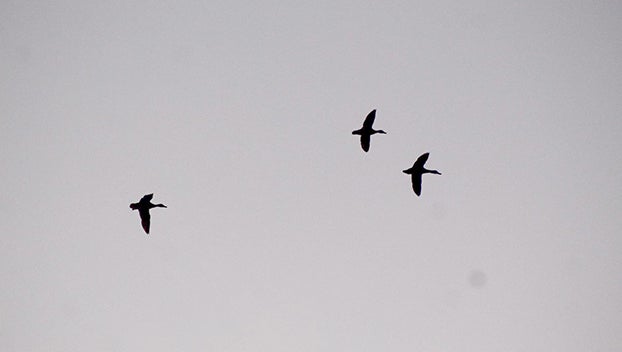Louisiana puts money where the ducks are
Published 4:12 pm Friday, July 7, 2023

- Three ducks fly over St. Catherine Creek National Wildlife Refuge south of Natchez. (File Photo | Hunter Cloud)
SASKATCHEWAN — Louisiana duck hunters indirectly fund habitat improvement and duck conservation in Saskatchewan, Canada each year through duck stamps. It is for good reason too, Saskatchewan accounts for 61 percent of the ducks harvested in Louisiana through data gathered on banded ducks.
Duck hunters in Mississippi also contribute to projects on northern breeding grounds when they purchase the federal and state duck stamp. You don’t have to duck hunt to help ducks. Anyone can purchase a Federal Duck stamp or give money to Ducks Unlimited or Delta Waterfowl to help support the habitat improvement projects to help waterfowl.
Alberta, Canada is the second greatest area to produce ducks for Louisiana accounting for 30 percent of harvests. Ducks Unlimited Canada and Delta Waterfowl are two groups who take the money from duck stamp programs and apply them to projects in Canada where ducks are produced. Commissioners with the Louisiana Department of Fish and Wildlife heard presentations on the projects during a meeting Thursday.
Ducks Unlimited Canada started in 1937 and Louisiana began sending money north to improve breeding habitat in 1965 and have contributed every single year amounting to $12.7 million invested in projects. DU Canada matched those funds to result in close to $50 million invested in the breeding grounds since 1965.
According to banding data, Louisiana hunters harvested 2,683,000 ducks from Saskatchewan. In the past year, LDWF sent $179,816.36 to be used in a land purchase to help produce more ducks. Dave Kostersky, with DU Canada, said the Hrushowy purchase adds 798.4 acres of the best waterfowl habitat and 258 acres of the purchase came from the LDWF funds.
Habitat work in Canada is focused on restoring wetlands and improving grasslands. Kostersky said they helped rebuild 39 acres of wetland, conserve 947 acres of forages, and impacted 1,782 acres in total.
“Grasslands are critical. People think about wetlands but half of our species require grassland to nest in. Without a healthy cattle industry you don’t have grass. You need grass on the landscape,” Kostersky said. “We can’t do it at the scale the cattle can. Our forage program helps convert land and it is imperative for the future of grasslands on the content. We need to work with cattle to ensure it continues. Help us work with those landowners on the landscape.”
DU’s project proposal for LDWF’s $589,500 is set to go towards 480 acres of conservation easements and 320 acres in acquisition in the next fiscal year.
Conditions in the prairie pothole region are classified as good thanks to needed precipitation. Last year, drought conditions limited the breeding habitat in Saskatchewan and Alberta. Kostersky said due to the improved conditions they should have an average year for waterfowl production.
“We are about building a legacy,” Kostersky said. “We want to continue that. Your dollars are a great turn on investment. We will work together. Thank you for the opportunity.”
John Davis, Vice President of Delta Waterfowl, gave a presentation on the adopt a pothole program which started in 1998. Much of their work is done in the Manitoba provinces. Since 1998, $224 million has been endowed for habitat work in Canada. Delta Waterfowl works on habitat improvement one easement at a time and incentivizing private landowners to keep water on the landscape.
He said May ponds have a direct correlation on waterfowl production and Louisiana harvest. A good year for pond counts in May leads to a good waterfowl harvest. Davis added their current Early Mid-continent production outlook is good based on wetland availability and conditions. Louisiana sent $59,940 in funds to Delta Waterfowl last year to improve 137 acres of habitat.
LDWF funds went towards 59.5 acres of wetland habitat and 77.5 acres of upland habitat. Delta Waterfowl is proposing to put $65,346 from the LDWF funding in the FY24 budget. It will be matched to reach a total of $261,384 invested in Manitoba in Fiscal Year 24. The investment would improve habitat in 120 acres of wetlands and 140 acres of upland habitat.




